Lupine Publishers | Current Investigations in Agriculture and Current Research
Abstract
Premises of the Research: Kiwi, Actidinia deliciosa is a temperate fruit with high nutritional and medicinal value which is commonly propagated through rootstock grafting. Low seed germination because of seed dormancy and chilling requirement limits seedling production which can be improved by chemical treatment and varietal selection.
Methodology: Germination response of three varieties viz. Abbot, Allison, Bruno pre-treated with 2000, 4000, 6000ppm of GA3 including control was studied in two factor Factorial Complete Randomize Design with six replications in laboratory of Lamjung Campus.
Pivotal Results: Significantly higher germination percentage (68.67%) was found in Bruno without pre-treatment of seed followed by Allison pre-treated with 6000ppm of GA3 (47.33%). GA3 alone significantly influenced mean germination rate and time. However, Allison with 6000ppm GA3 had fastest mean germination rate (0.059 day-1) and time (17 days). Statistically different germination index, coefficient of variation of germination time and uncertainty of germination was found.
Conclusion: Seed germination can be enhanced by treating 4000-6000ppm GA3 for Abbot, Allison while Bruno requires no pretreatments of seeds.
Keywords: Dormancy; Germination Percentage; Mean Germination Time; Pre-treatment; Vigor
Introduction
Kiwi fruit (Actnidia deliciosa (A Chev)) called as ‘Chinese Gooseberry’ is native to Yangtze valley where it evolved with the southeastern subtropical flora [1]. It is planted in T-bars or pergola and woody vines can go up to 9m height. The Kiwi fruits can withstand up to -15oC and flower appearance takes in the spring [2]. The fleshy fruits with seeds embedded inside are called berries which are of different size, shape, color and hairiness [3].
The global Kiwi production reached 4.27 billion metric ton in 2016 [4]. The export trade of kiwi is increasing year over year, increased 8.1% in 2016 to 2017. In 2017, the major exporter are European countries (mainly Italy and Belgium) 43.9% and Oceanian countries (mainly New Zealand) 43.7%. New Zealand is the largest exporter while China is the largest producer of Kiwi fruit. Nepal ranked 83rd in Kiwi exporter with 0.0001% world total export. The export was about $3000 only. There is a good opportunity to country like Nepal with negative net export to increase the production of Kiwi for export which would decrease the overall trade deficit (Workman, 2018). Kiwi fruit is gaining popularity and cultivated commercially by farmers of Kabrepalanchowk, Lalitpur, Kathmandu, Dolakha and Illam districts where sapling is supplied by a nursery in Kabrepalanchowk and by ICIMOD. It can be a source of cash income to farmers to improve livelihood. Also, in sloping land it helps in erosion control and sustainable land management practice. In the areas, economic yield is 40 to 60Kg per vine of 5 to 8 years old vines or 20 to 25tons per hectare [5].
Kiwifruit is propagated either sexually or asexually by grafting, micro-propagation or cutting and grafting on seedling rootstock is common commercial practices [6]. But the seed have low germination capacity [7] which makes Kiwi propagation difficult in general ways. During favorable condition and germination permissive environment too, seed germination is poor and erratic due to seed dormancy [8-12]. Stratification under cool and moist condition or gibberellic acid treatment improves germination rates [13,14]. Treatment with 2500ppm of gibberellic acid gives 31. 67% germination [15]. The higher concentration of gibberellic acid of about 2000ppm to 6000ppm for 24 hours shortens the germination period [16]. The use of GA3 primed seed is believed to increase the seed germination and seedling vigor. Since, the germination of Kiwi seed is low and there were unsatisfactory researches based on single factor it was necessary to combine several factors to increase Kiwi seed germination [17]. Thus, we used two factor CRD in this experiment to enhance seed germination of different varieties of Kiwi and specifically, to determine germination parameters of Kiwi seed.
Methodology
Preparation of Materials (seed and solution)
The fruits of Kiwi after a week of harvest were used for seed extraction: peeled, cut and crush to separate seed from pulp. These seed were cleaned (rinsed with water), dried and were packed in polythene seed packet before priming. The GA3 powder was dissolved in water using ethanol (99%) and slight heat to get required concentration viz. 2000ppm, 4000ppm and 6000ppm.
Experimental Design
Laboratory test was performed in Horticulture Laboratory, Lamjung Campus. A two-factor factorial Complete Randomize Design with six replications were used with following treatments:
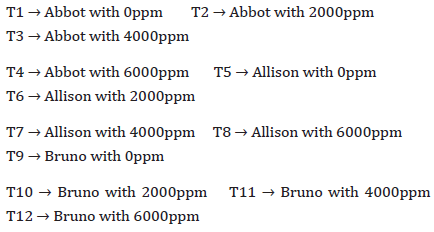
Each of treatment had 150 seeds with 25 seeds in each of 6 replications. 12 beakers each containing 150 seed of 3 variety in equal proportion were taken. Distilled water, 2000ppm GA3, 4000ppm GA3 and 6000ppm GA3 was poured twice their volume and primed for 24 hours and dried for next 24 hours. Petri-dish covered with moistened filter paper (12mm) was used. Petridish was put for germination at 22oC in darkness in germinator. Rehydration for moisture maintenance was done as required.
Data Collection and Statistical Analysis
Each day scoring of each petri-dish was recorded, counting germinated when sprout is 2mm long. The scoring was done until no germination for 3 consecutive days. Removal of molded and dead seeds were continuous in the test period. The data from the test datasheet were used for calculating following parameters using excel.
Germination Date: According to Labouriau [12], First Day of Germination: to = Time for the first germination known as First Germination of Day (FDG). Last Day of Germination: tg = Time for the last germination known as Last Germination of Day (LDG). Time Spread of Germination (TSG): It is time in days between FDG and LDG in a germination test period.
Germination Percentage (GP): According to Labouriau [12], it is percentage of seed in which germination process ends to the sample taken in the experiment conducted.

Mean Germination Time (MGT): According to Labouriau (1983a),
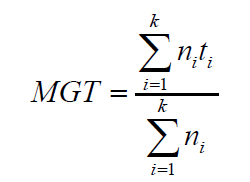
Coefficient of Velocity of Germination (CVG): It is reciprocal of Mean Germination Time. According to Nichols & Heydecker [18],

Coefficient of Variation of Germination Time (CVt)

Germination Index (GI): As per Throneberry and Smith’s method, adopted by Maguire [19]
 and Timson
and Timson 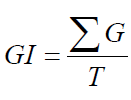 Ajmal Khan & Ungar
(1998)
Ajmal Khan & Ungar
(1998)
Uncertainty of Germination Process (U): According to Labouriau & Valadares [20]
 where fi = relative frequency of germination
where fi = relative frequency of germination 
Synchrony of Germination (Z): According to Primack [21],
 where
where 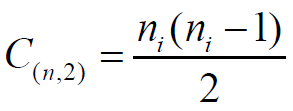 combination of seeds
germinated in i time
combination of seeds
germinated in i time
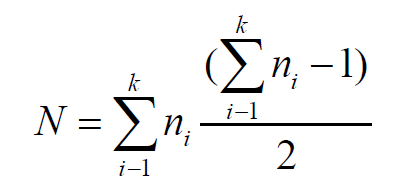
Seedling Vigor Index (SVI): According to Abdul-Baki and Anderson [22]

Where Sl = Average shoot length (cm)
Rl = Average root length (cm)
In above formulae,
ni = number of seeds germinated in the sample ith day or time observation
N = number of seeds taken in sample
ti = day or time of experiment from start to ith observation
k = last day or time of observation
G = Germination percentage and T = Germination Period
The parameters taken were statistically analyzed by Fischer test in two-factorial ANNOVA Complete Randomize Design in R - Stat 3.1.3 software package. The mean separation was performed by Duncan’s Multiple Range Test at 0.05 probability level.
Result
Number of Seed Germinated Per Day During Germination Period
The first day of germination was 9th day and last day of germination was 38th day after sowing. Accordingly, time spread of germination (Germination Period) was of 30 days (Figures 1-4). The experiment revealed among Kiwi varieties without pretreatment of GA3, the variety Bruno had higher number of germinated seeds per day. This was significantly higher in the period of 19th to 33rd days after sowing (Figure 1). On the other hand, among seed pretreated with 2000ppm of GA3 Allison variety showed higher germinated seed per day during period 9th to 28th day after sowing which was significant (Figure 2).
Likewise, among the seed pretreated with 4000ppm of GA3, Allison had significantly greater number of germinated seeds during period of 9th to 23rd day (Figure 3). While, both Allison and Bruno had similar and statistically higher number of germinated seeds per day than. Abbot, among the seeds pretreated with 6000ppm of GA3 (Figure 4).
Effect of variety and GA3 on germination parameters viz. GP, MGT, CVT, MGR, U, Z, CVG and GI of Kiwi seed.
Significant difference was found between influence of variety and GA3 on the parameters of germination viz. Final Germination Percentage, Coefficient of Variation of Germination Time, Uncertainty of Germination and Germination index whereas for Mean Germination Time, Mean Germination Rate, Synchrony of Germination and Coefficient of Velocity of Germination wasn’t significant (images 1).
Table 1: Interaction effect of variety and GA3 on GP, MGT, CVt, MGR, U, Z, CVG and GI of Kiwi seed.
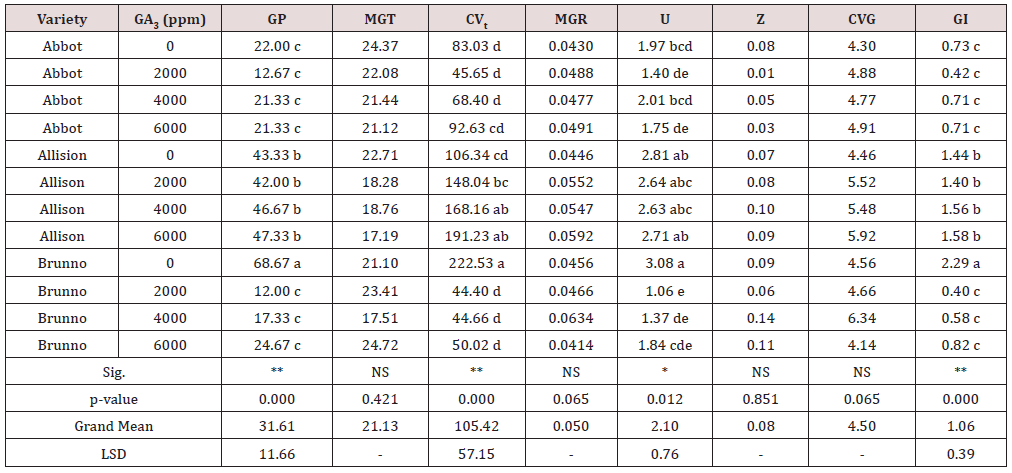
Note: GP → Germination Percentage (%), MGT → Mean Germination Time (day), CVt →Coefficient of Variation in Germination Time (%), MGR → Mean Germination Rate (day-1), U → Uncertainty of Germination Process (bit), Z → Synchrony of Germination (unit less), CVG → Coefficient of Velocity of Germination (%), GI → Germination Index (seed day-1)
*p – value < 0.05
**p – value < 0.01
Germination Percentage
Bruno with 0ppm of GA3 had significantly higher germination percentage (68.67%) than other treatments. It was followed by Allison with 6000ppm statistically at par with 4000ppm, 2000ppm and 0ppm. Minimum germination was found in Bruno with 2000ppm (12.00%) which was statistically at par with Abbot with 2000ppm, 4000ppm and 6000ppm; Bruno with 4000ppm and 6000ppm. This showed germination capacity of Kiwi seed is influenced by gibberellic acid concentration. Allison with 6000ppm with higher followed by continuously decreasing germination with 4000ppm, 2000ppm and 0ppm which clearly showed stimulating effect of the gibberellic acid on germination of Allison seed whereas opposite effect in Bruno variety indicated gibberellic acid at higher concentration can have inhibitory effect on germination as well.
Mean Germination Time
The overall Mean Germination Time was found to be 21 days and shortest time of germination was for Allison with 6000ppm (17 days) and longest time of 24 days was taken by Abbot with 0 ppm which was at par with 24 days taken by Bruno with 6000ppm which again showed negative effect of gibberellic acid on Bruno.
Mean Germination Rate
Mean Germination Rate is reciprocal to Mean Germination Time mathematically which was showed by analysis too which is Allison at 6000ppm (0.059 day-1) had maximum rate and Abbot with 0ppm along with Bruno with 6000ppm had the slowest rate.
Coefficient of Variation of Germination Time
Bruno with 0ppm (222.53%) had highest coefficient of germination time which was statistically at par with coefficient of Allison with 6000ppm and 4000ppm. Furthermore, both Abbot and Bruno with 6000ppm, 4000ppm and 2000ppm; and Allison with 0ppm had statistically inferior coefficient of variation of germination time.
Uncertainty of Germination
The germination was most spread for Bruno with 2000ppm with uncertainty of germination 1.06 bit which is statistically at par with Bruno with 4000ppm and 6000ppm along with Abbot with 6000ppm. The degree of spreading time of germination was least for Bruno with 0ppm followed by Allison with 6000ppm, 4000ppm, 2000ppm and 0ppm. As a whole 2.1-bit uncertainty of germination indicated Kiwi seed has a higher degree of germination in germination period.
Synchrony of Germination
The grand mean of Synchrony of Germination 0.07 indicated negligible degree of overlapping was seen in germination. Being non-significant greater synchrony was for Allison with 4000 (0.10) and Bruno with 6000ppm (0.11) and lowest for Abbot with 2000ppm (0.01).
Coefficient of Velocity of Germination
The number of seeds germinated per unit time was greater for Bruno with 4000ppm with CVG of 3.41% followed by Allison with 6000ppm, 4000ppm and 2000ppm. It is similar to the rate of germination.
Germination Index
The germination index was found to be maximum for Bruno with 0ppm statistically superior to others. All GA3 treatments of Abbot and Bruno (excluding with 0ppm) has lower germination index than Allison with GA3 treatments.
Effect of variety and GA3 on Seedling Vigor Index and Root Shoot Ratio
Seedling Vigor Index (295.18) was greatest for Allison with 6000ppm and lowest for Bruno with 6000ppm and lowest for abbot with 0ppm GA3 which had no difference statistically (Figure 5). The Root Shoot Ratio of the Kiwi germinated seed after 38th day of sowing (Figure 6). The average Root Shoot Ratio was 0.2235 for the Kiwi and variety Allison, Abbot and Bruno had 0.2310, 0.2253 and 0.2145 as Root Shoot Ratio respectively.
Figure 5: Seedling Vigor Index of Kiwi germinated seed pretreated with different concentration of GA3.

Discussion
Number of Seed Germinated Per Day During Germination Period
The first day of germination was 9th day after sowing which is earlier than first germination after 1 month of harvest [23]. Furthermore, last day of germination was 38th day after sowing, while findings show in control condition it takes 52 days to complete germination [24]. Accordingly, spread of germination (Germination Period) of 30 days is also shorter than that at normal condition. This result is supported by reasons that period of germination is shorten by 2000 -6000ppm of GA3 priming for 24 hours [25,16]. These shortening of first and last day of germination is due to GA3 effect on rate of germination. This effect is due to increased imbibition of water for initiation of germination and increased cell division [26]
Germination Percentage
The result for germination percentage of Bruno variety is in accordance to Mattiuz et al. [27] that low germination of 35.47% seeds treated with 6000ppm GA3 than germination of 36.85% with 2000ppm. The findings of Ozcan and Erisgin [15] that 6000ppm of GA3 has low germination (35%) than 2000ppm of GA3 with germination (44%) also similar to our result.
On the other hand, researchers have performed experiments which resulted higher germination at higher concentration of GA3 such as 79% germination at 6000ppm GA3 and 28% germination of untreated seeds [17]. This findings are in accordance to the result of variety Allison and Abbot in this experiment. The germination stimulating role of GA3 in Allison and Abbot variety is mainly due to breaking of dormancy that substituted necessity of stratification [28]. Its acts on germination promotion as it removes impermeability of seed coat [29] and it helps exposing macrosclereids cells in imbibition of water for initation of germination [26]. Its affect in cell division and dry weight gain which shows marked effect on seedling growth [28]. However, the germination retarding or negative effect in Bruno variety is due to low chilling requirement of the variety which is ill affected by higher concentration of GA3. This inhibition can be compared to findings that germination inhibition is nearly associated with stimulation which appers in different concerntration, sometimes one after another [30]. The performance of untreated seeds can further be explained from previous facts that germination is improved by activity of antioxidants like superoxide dimutase, catalase and ascornbate peroxidae which is achieved by hydro priming only [31].
Mean Germination Time
The overall Mean Germination Time was found much lower than that previously reported Kiwi seed takes 52 days for germination [24] at 15oC under controlled condition which indicates GA3 hastens the process of germination and increase rate. This finding of shorten mean germination time on seed priming is supported by result of Lawes and Sim [25] that GA3 2000 - 6000ppm shortens germination period. This is because GA3 helps in early seed emergence and growth [32,33]. Overall period and time of germination shortened because of dormancy breaking action of GA3. It stimulates hypocotyl growth by initiation of cell division and elongation by primarily acting on cell division, then on cell enlargement [34,35].
Mean Germination Rate
Findings of Ynoue et al. [14] that chemical treatments using GA3 for 24 hours or stratification increases germination rate supports this result of overall increase in germination rate which also resulted shortened mean germination time.
Germination Index
The result indicates that variety had greater influence in germination index while it is less effected by GA3 concentration. The average germination index of 1.05 (higher than 100%) showed similar germination per day of Kiwi seed in germination period. The similarity and correspondence in GP and GI show to the report that use of germination percent eliminates the effect of sample size to calculate germination index than number of seeds germinated [36].
Seedling Vigor Index
Ashraf and Foolad [37] reported seed primining enhance the seedling vigour which contrasts our findings. Also, higher superior seed vigor index and seedling dry weight than non-primed cowpea seed [38-40] contrast our finding.
Conclusion
It can be inferred from the experiment that GA3 primed seed have faster germination rate and lower mean germination time than hydro-primed seed. Seed germination can be enhanced by treating 4000-6000ppm GA3 for Abbot, Allison while Bruno requires no pretreatments of seeds.
Read More Lupine Publishers Agriculture Journal Article:

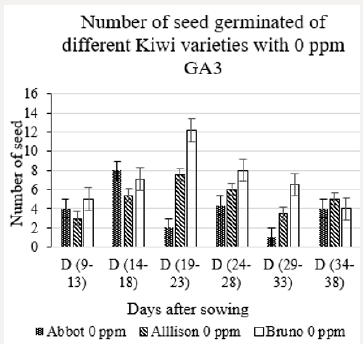
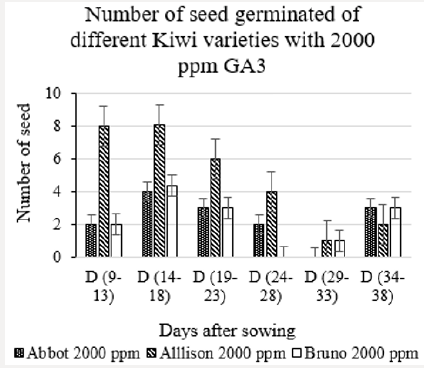
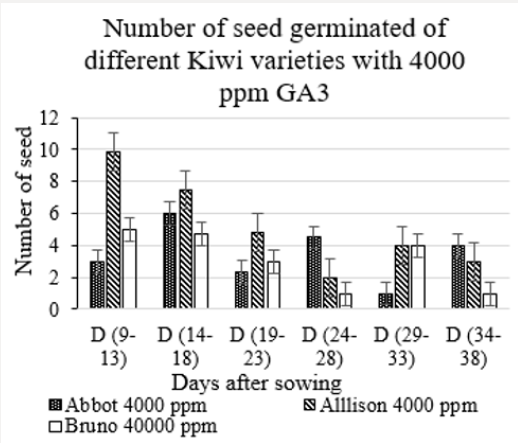
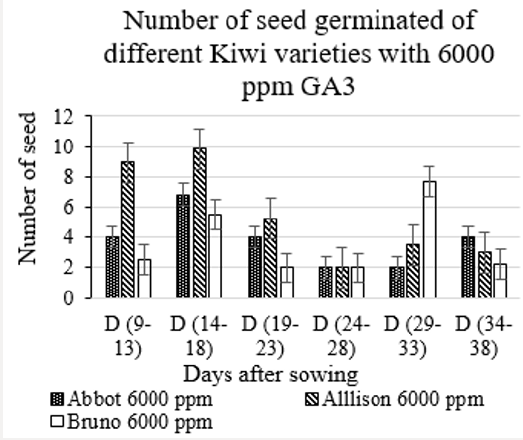
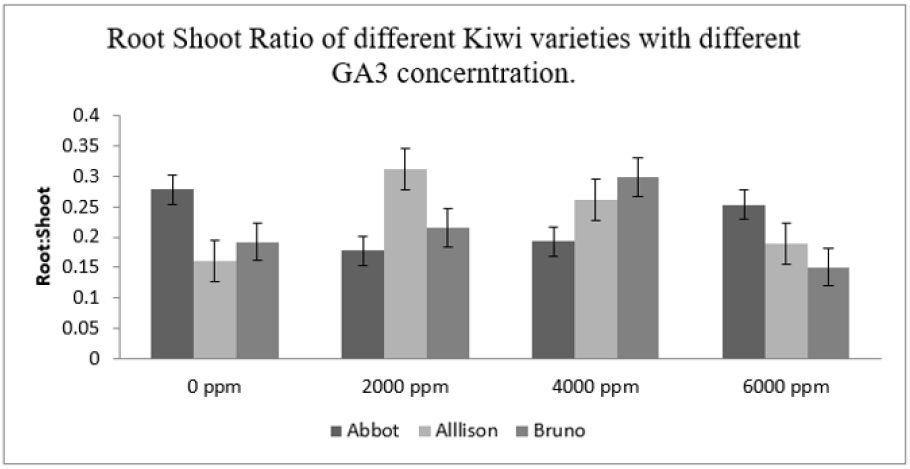
No comments:
Post a Comment
Note: only a member of this blog may post a comment.